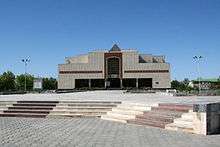Nukus Museum of Art

Nukus Museum of Art (Uzbek: Qoraqalpogʻiston davlat sanʼat muzeyi) or, in full, The State Art Museum of the Republic of Karakalpakstan, named after I.V. Savitsky is an art museum based in Nukus, Uzbekistan. Opened in 1966, the museum houses a collection of over 82,000 items, ranging from antiquities from Khorezm to Karakalpak folk art, Uzbek fine art and, uniquely, the second largest collection of Russian avant-garde in the world (after the Russian Museum in St. Petersburg).
The museum represents the life’s work of Igor Savitsky, whose legacy, which includes thousands of artistic and cultural treasures on permanent exhibition, make this building one of the most interesting repositories of ancient and modern art.[1]
Savitsky, the founder
The Russian painter, archeologist and collector, Igor Savitsky, first visited Karakalpakstan in 1950 to participate in the Khorezm Archeological & Ethnographic Expedition and later moved to Nukus, Karakalpakstan’s capital, and continued living there until his death in Moscow in 1984. During 1957-66, he assembled an extensive collection of Karakalpak jewellery, carpets, coins, clothing and other artifacts, convinced the authorities of the need for a museum, and, following its establishment, was appointed its curator in 1966.[2]
Thereafter, he began collecting the works of Central Asian artists, including Alexander Volkov, Ural Tansykbayev and Victor Ufimtsev of the Uzbek school, and later those of the Russian avant-garde — including Kliment Red'ko, Lyubov Popova, Mukhina, Ivan Koudriachov and Robert Falk — whose paintings, although already recognized in Western Europe (especially in France), had been banned in the Soviet Union during Joseph Stalin’s rule and through the 1960s.
Despite the risk of being denounced as an “enemy of the people”, Savitsky sought out proscribed painters and their heirs to collect, archive and display their works; and, with great courage, he managed to assemble thousands of Russian avant-garde and post avant-garde paintings. Moreover, refuting the Socialist Realism school, the collection shook the foundations of that period of art history.[3]
It was not until perestroika in 1985—the year after he died—that Savitsky’s remarkable achievements and collections were truly acknowledged, and not until 1991—when Uzbekistan became independent—that Nukus, a remote ‘closed’ city during the Soviet Union, became accessible to the outside world.[4] Since then, exhibitions in France (Caen, 1998),[4] Uzbekistan (Tashkent, 2001, 2002 and 2003) and Russia (planned for 2008) have brought Savitsky’s bequest to the attention of a wider international audience.
Today, the number of its admirers and supporters in Uzbekistan and around the world, while still relatively few, is gradually increasing, and this vast collection of Russian art has become a “must-see” for any visitor to Uzbekistan—and an addition to the conventional itinerary and traditional cultural sites of Samarkand, Bukhara and Khiva. Following its move to a new building in 2003, the Nukus Museum is now one of the finest in Uzbekistan—and in all of Central Asia.
Friends of Nukus Museum
Set up initially in Tashkent [5] as an informal group during the early 1990s and later registered in Karakalpakstan as a non-governmental organization (NGO) in 2001,[6] the Friends of Nukus Museum (FoNM) is a small, but dedicated international network of advocates and supporters. In 2007, it was re-constituted as the Friends of Nukus Museum Foundation, based in the Netherlands.
Marinika Babanazarova, Savitsky’s successor as the Museum’s curator, has been involved in presenting more than 20 exhibitions—in France, Germany, Russia, and the United States as well as in Uzbekistan.,[7] Her essays have featured in five exhibition catalogues, including the best selling Avangard, ostanovlennyi na begu (Avant-Garde Stopped on the Run) .[8]
References
- ↑ Steppe Magazine, issue 3, December 2007
- ↑ Tom Bissell, Chasing the Sea, Pantheon (2003). ISBN 0-375-42130-0. p. 323–324.
- ↑ https://www.vice.com/en_uk/read/the-uzbek-museum-of-banned-soviet-art
- 1 2 New York Times, January 4, 1998
- ↑ BBC News, 14 May 2001. Appeal to save unique Soviet art
- ↑ Eurasia.org, May 25, 2001. Friends of Nukus Museum Work to Preserve Unique Collection
- ↑ Marinika Babanazarova
- ↑ Avangard, ostanovlennyi na begu, Avrora(1989). ISBN 5-7300-0223-8
External links
| Wikimedia Commons has media related to Nukus Museum of Art. |
Coordinates: 42°27′53″N 59°36′08″E / 42.46472°N 59.60222°E
.jpg)